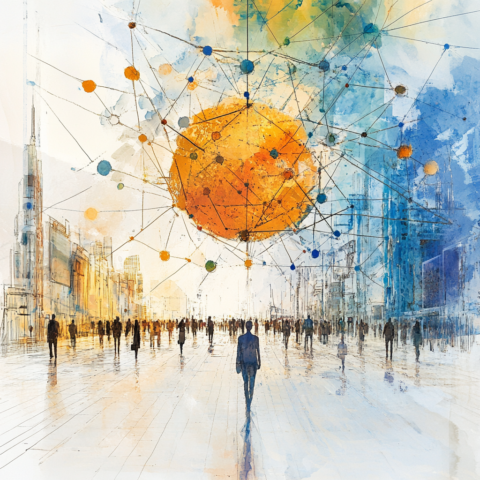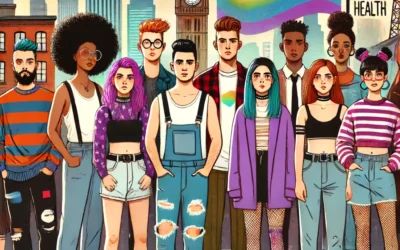In the ever-evolving game of commerce, something new has emerged, weaving together the digital and physical realms into a seamless experience. This phenomenon, aptly termed “phygital,” represents a paradigm shift that challenges traditional notions of retail and consumer interaction. As society grapples with the implications of this transformation, it becomes imperative to examine the origins, manifestations, and potential consequences of this retail revolution.
The Genesis of Phygital

The roots of the phygital concept can be traced to the inexorable rise of e-commerce, which disrupted established retail models and forced traditional brick-and-mortar stores to adapt or face obsolescence. The evolution of phygital retail can be understood through the following key stages:
- E-commerce Emergence: The initial challenge to traditional retail models
- Click-and-Collect: Early attempts to bridge online convenience with physical store presence
- Mobile Revolution: Smartphones become portals for price comparison, reviews, and purchases
- IoT Integration: Physical stores begin incorporating smart technologies
- AR/VR Adoption: Augmented and virtual reality enhance in-store and online experiences
- Pandemic Acceleration: COVID-19 compresses years of digital transformation into months
The global pandemic of 2020 acted as an accelerant, compressing years of digital transformation into months. As physical stores shuttered and online shopping surged, retailers were compelled to innovate at an unprecedented pace. The result was a rapid evolution of phygital experiences designed to satisfy the craving for convenience without sacrificing the human element of shopping.
The Phygital Landscape
The manifestation of phygital retail is a testament to the ingenuity of modern commerce. Consider the following examples of phygital innovations:
| Technology | Application | Example |
|---|---|---|
| Augmented Reality (AR) | Virtual try-ons | Nike’s AR mirrors for footwear |
| Internet of Things (IoT) | Smart inventory management | Amazon Go’s checkout-free stores |
| Artificial Intelligence (AI) | Personalized recommendations | Sephora’s AI-powered skincare advisor |
| Near Field Communication (NFC) | Contactless payments | Apple Pay in physical stores |
| Beacon Technology | Location-based offers | Macy’s in-store notifications |
These technologies are not merely gimmicks but represent a fundamental shift in how consumers interact with brands and products. The essence of phygital extends beyond technological spectacle; it represents an attempt to create a seamless, personalized experience that caters to the dual nature of modern consumers as both digital natives and physical beings.
The Psychology of Phygital
The psychological underpinnings of the phygital phenomenon are complex and multifaceted. Several key factors drive consumer adoption of phygital experiences:
- Novelty Seeking: Humans are wired for new experiences, and phygital offerings satisfy this craving
- Instant Gratification: The blend of digital convenience and physical immediacy caters to modern expectations
- Personalization: Tailored experiences make consumers feel valued and understood
- Social Connection: Phygital platforms can facilitate shared experiences, even in digital spaces
- Control: The ability to seamlessly switch between digital and physical interactions gives consumers a sense of empowerment
Perhaps most significantly, phygital experiences address the human desire for connection. In an increasingly digital world, there is a palpable hunger for authentic, human interactions. By melding digital convenience with physical presence, phygital shopping creates opportunities for meaningful engagement—with products, brands, and fellow humans.
Challenges and Ethical Considerations
 Like any paradigm shift, the phygital revolution is not without its challenges and ethical quandaries. Several key issues demand attention:
Like any paradigm shift, the phygital revolution is not without its challenges and ethical quandaries. Several key issues demand attention:
- Privacy and Data Security
- Tracking of consumer behavior across digital and physical spaces
- Potential for data breaches and misuse of personal information
- Erosion of anonymity in physical retail environments
- Digital Divide
- Risk of alienating less tech-savvy consumers
- Potential exacerbation of existing socioeconomic inequalities
- Need for inclusive design in phygital experiences
- Environmental Impact
- Energy consumption of data centers and IoT devices
- Electronic waste from constant technology upgrades
- Potential for more efficient inventory management and reduced waste
- Consumer Agency
- Risk of AI algorithms overly influencing consumer choices
- Potential for manipulation through hyper-personalized experiences
- Need for transparency in how recommendations are generated
- Job Displacement
- Automation of certain retail roles
- Shift in required skills for retail employees
- Need for retraining and education programs
Addressing these challenges will require collaboration between retailers, technology developers, policymakers, and consumers. It is crucial to establish ethical guidelines and best practices that protect consumer interests while fostering innovation.
The Human Element in Phygital Retail
Amidst the excitement over cutting-edge technologies, it is crucial not to lose sight of the human element. The most successful phygital experiences are not merely about showcasing technological prowess; they are about enhancing human connections and emotions.
Consider the concept of “retail therapy.” It transcends mere acquisition; it encompasses the experience, the thrill of discovery, the social aspect of shopping with companions. The challenge lies in replicating—or even enhancing—these emotional components of shopping through phygital means.
Some retailers have found innovative approaches to this challenge:
- Virtual Shopping Assistants: Combine AI with human expertise for personalized advice
- Social Shopping Platforms: Enable friends to browse and shop together, even when physically separated
- Interactive Storytelling: Use AR to create immersive brand experiences in-store
- Community Building: Leverage social media integration to create a sense of belonging
- Sensory Marketing: Incorporate touch, smell, and sound into digital experiences
The key lies in utilizing technology not as an end in itself, but as a tool to create more meaningful, emotionally resonant experiences. It’s about leveraging digital wizardry to infuse the physical world with a sense of magic, connection, and humanity.
The Road Ahead
As society stands on the threshold of this phygital future, one thing is abundantly clear: there is no reverting to the status quo ante. The proverbial genie is out of the bottle, and consumers who have experienced the convenience and excitement of phygital experiences are unlikely to settle for less.
The road ahead is replete with possibilities:
- Virtual Reality Shopping
- Fully immersive virtual stores
- 3D product browsing and interaction
- Global social shopping experiences
- Biometric Payments
- Facial recognition for transactions
- Fingerprint or retinal scan checkouts
- Integration with wearable devices
- Hyper-Personalization
- AI-driven store layouts
- Real-time product recommendations
- Customized pricing and promotions
- Sustainable Shopping
- Virtual try-ons to reduce returns
- Blockchain for supply chain transparency
- AI-optimized inventory to reduce waste
- Autonomous Retail
- Self-driving delivery vehicles
- Robotic store assistants
- Drone-based inventory management
These innovations promise to revolutionize not just how we shop, but how we interact with brands, products, and each other in commercial spaces.
The Broader Implications
The phygital revolution transcends mere shopping. It represents a reimagining of how humanity interacts with the world, blending the best of digital and physical realms to create experiences that are more convenient, more personalized, and ultimately, more human.
Consider the potential impact on various sectors:
| Sector | Phygital Application | Potential Impact |
|---|---|---|
| Education | AR/VR classrooms | Enhanced engagement and remote learning |
| Healthcare | Telemedicine with IoT devices | Improved patient monitoring and care |
| Entertainment | Mixed reality experiences | Immersive storytelling and interactive content |
| Urban Planning | Digital twins of cities | Optimized infrastructure and services |
| Workplace | Hybrid office-home setups | Flexible work arrangements and improved collaboration |
As the boundaries between digital and physical cease to exist, society is challenged to reconsider fundamental concepts of interaction, privacy, and even reality itself. The phygital revolution may well be a harbinger of a new era where the distinction between online and offline becomes meaningless.
Navigating the Phygital Frontier
The phygital revolution is not just a transformation of retail; it is a paradigm shift that will reshape how people perceive and engage with the world around them. As this new reality unfolds, it presents both exciting opportunities and significant challenges.
For businesses, the imperative is clear: adapt to the phygital landscape or risk obsolescence. This adaptation will require:
- Investment in cutting-edge technologies
- Reskilling of workforce
- Reimagining of customer experiences
- Prioritization of data security and ethical use of information
For consumers, the phygital revolution offers unprecedented convenience and personalization, but also demands vigilance:
- Understanding of data privacy implications
- Critical evaluation of AI-driven recommendations
- Balancing digital convenience with human connection
- Supporting brands that align with personal values
For society at large, the phygital shift raises profound questions:
- How to ensure equitable access to phygital experiences?
- What regulations are needed to protect consumer interests?
- How to mitigate the environmental impact of increased technology use?
- What does it mean to be “human” in a world where digital and physical merge?
As we navigate this new frontier, it is crucial to approach the phygital revolution with both enthusiasm and caution. The potential for enhancing human experiences and solving complex problems is immense, but so too are the risks of exacerbating inequalities and eroding privacy.
The phygital future is not predetermined; it will be shaped by the choices made by businesses, consumers, and policymakers in the coming years. By prioritizing human needs and ethical considerations alongside technological innovation, we can strive to create a phygital world that enhances rather than diminishes our humanity.
In this brave new world where bits and atoms converge, the ultimate challenge—and opportunity—is to harness the power of phygital experiences to create a more connected, efficient, and empathetic society. The revolution has begun; how we shape it is up to us.



